The B2C marketer’s guide to customer loyalty programs
Wouldn’t it be wonderful if people shared our products with their friends, bought from us every month, and raved about us on their socials?
According to Klaviyo’s Future of Consumer Marketing report, consumers are only loyal to between 1 to 5 brands, and predict that in the next 6 months, economic conditions will lead them to look for more discounts or to shop with more affordable brands. Customer feedback and reviews are the most influential factor in purchase decisions. And, word of mouth influences 1 in 5 consumers to try new restaurants and 1 in 8 to try new wellness or personal service brands.
In other words, loyalty matters. A lot.
The most successful B2C brands sell great products and invest in lasting customer relationships. And they’re able to keep up by using a B2C CRM to unify their customer data across marketing, commerce, and customer service. This means rewards programs can be more effective, automated, and personalised—and drive more revenue.
What is a customer loyalty program?
A customer loyalty program is a rewards system brands use to encourage repeat purchases and build long-term customer relationships.
Here’s how it typically works: when customers make purchases, they earn points, discounts, or other perks they can redeem later. They might earn points for every dollar spent, and once they reach a certain number of points, they can claim a discount on their next purchase.
Loyalty programs are win-win. You get stronger customer retention rates and shoppers get discounts, freebies, or insider access.
The business case for loyalty program marketing
When loyalty programs work as intended, they increase customer lifetime value (CLV) while lowering customer acquisition cost (CAC).
Acquiring new customers can be five times more expensive than retaining existing ones. Loyal customers already trust you, so they’re more likely to make repeat purchases—which gives your revenue a nice bump without needing to reach new audiences. They’re also more likely to become brand advocates, bringing in new customers through word-of-mouth.
“Our average customer spends £150 a year with us. But a customer subscribed to our loyalty program spends £350—an extra £200 a year,” says Scott Shashua, managing director of The Couture Club.
A recent study found that brands see an average return on investment (ROI) of 4.8x from loyalty programs. Loyal customers are also 50% more likely to try new products and spend 31% more than new customers.
Building strong, long-term relationships with customers helps brands stand out from the competition and differentiate themselves from others in their category. “Loyalty is so important to DTC brands,” says Jennifer K., director of DTC acquisition and retention marketing at Helen of Troy.
6 popular types of loyalty programs
The most effective customer loyalty programs combine convenience and incentives to give people the most value. These are the 6 most popular types of loyalty programs, and examples of brands using this type of program. Note that they overlap with each other all the time.
Did you know? 2025 Klaviyo consumer research found that 72% of consumers participate in retail and ecommerce brand loyalty programs. And just about half are members of personal/wellness brand loyalty programs (47%), restaurant loyalty programs (51%), and hotel loyalty programs (49%). No matter your B2C industry, loyalty matters to nearly half or more of your audience.
1. Point-based loyalty programs
Point-based loyalty programs allow customers to accumulate points from purchases and redeem those points for rewards. They’re a low barrier to entry for people who may shop with you out of habit or convenience. Points are sometimes the nudge people need to spend just that little bit more to get an item they want. And if enough people spend that little bit more, you can generate a sizable chunk of revenue to offset CAC.
The downside of point-based loyalty programs is that they fail to provide the instant gratification that’s essential for keeping customers engaged. Consider taking a hybrid approach and combining this strategy with another loyalty program type.
Happy V is a subscription-based vaginal, gut, and menopausal health brand. The brand sends 7 loyalty-triggered flows and quarterly campaigns to subscribers reminding them to redeem points. Happy V has seen 6.6x YoY growth in loyalty point redemption attributed to Klaviyo flows in Q2 2023, and 430% YoY growth in YTD Klaviyo-attributed revenue in September 2023.
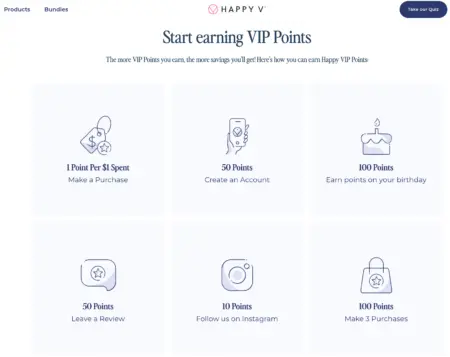
Source: Happy V
2. Tiered loyalty programs
Tiered loyalty programs reward customers with different levels of benefits based on behaviour like purchase volume or order history. You’ll be able to tell that your tiered program is working if customers keep upgrading over time.
Tiered programs also rely on choice and opportunity to upgrade. One person’s reason to upgrade will be different from another’s, so the more choice available, the better.
HOMAGE, an apparel company, gives SMS subscribers first dibs on new drops. Using Klaviyo SMS, HOMAGE sends automatic reminders about loyalty points and progress toward unlocking higher tiers in their loyalty program. The first campaign HOMAGE ran through SMS saw an 86.9% click rate and generated $167 in revenue per recipient.
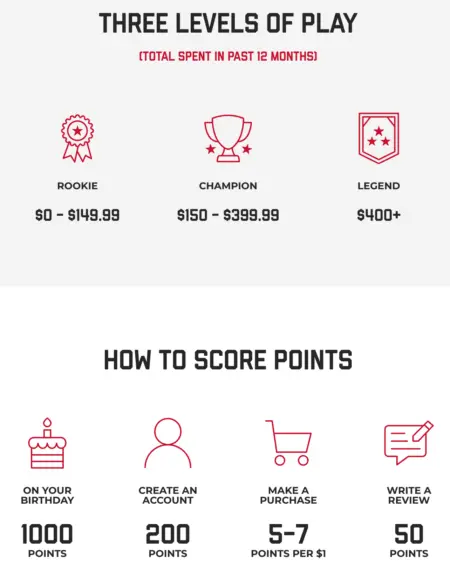
Source: HOMAGE
3. Paid loyalty programs
If you can pull it off, a paid loyalty program can generate massive amounts of revenue. First, because you’ve achieved the type of brand status that would justify paid membership, and second, because they’re actually highly profitable. According to McKinsey, 62% of customers spend more with a brand after joining their paid loyalty program.
CorePower Yoga, an in-person and virtual yoga studio, offers a paid membership that includes perks like discounts, curated partner offers, and priority booking.
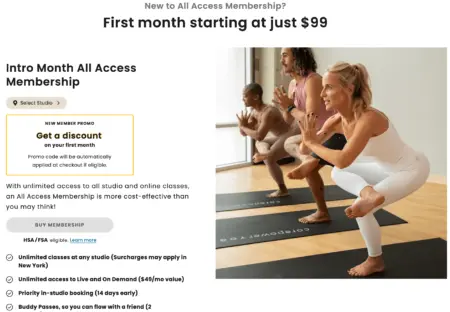
Source: CorePower Yoga
4. Partnered loyalty programs
Partnered loyalty programs are born when companies within complementary industries that are not competitors work together to create a loyalty program. This could look like an airline partnering with a hotel chain, allowing travelers to apply frequent flier miles to their stay, or a coffee shop partnering with a local bookstore to provide discounts on purchases.
Marine Layer, a responsible clothing brand, partnered with Trashie to incentivise customers to send back unwanted items to be repurposed. As a reward for recycling, they offer customers $40 in credit with the brand.
5. Gamified loyalty programs
Gamified loyalty programs incentivise actions by turning them into small games or competitions, then awarding benefits upon successful completion.
To be successful, gamified programs need to be, well, fun. At the very least, they should focus on a high exchange of value. The most common thing you want as a brand are reviews, referrals, and social media shares. Customers need to feel like they’re getting something worth it in return.
The Body Shop, a skincare brand, has a loyalty program called the Love Your BodyTM Club. As a part of the program, members can earn points, get birthday coupons, and win prizes for hitting certain milestones.
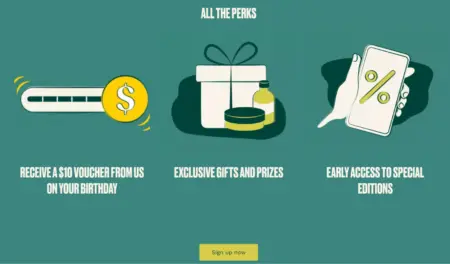
Source: The Body Shop
6. VIP loyalty programs
A VIP loyalty program rewards a company’s most loyal customers. Choose perks and benefits wisely and make eligibility criteria clear, so customers are incentivised to reach your top tier.
30% of US consumers expect ecommerce brands with customer loyalty programs to offer VIP tiers, so think through the VIP-specific experience for your loyalty program.
Dollar Shave Club, a subscription shaving brand, has a point-based program with VIP perks. As customers spend more and get to “Gold status,” they unlock bigger point bonuses, invites to exclusive events, early access to products, and more personalised benefits.
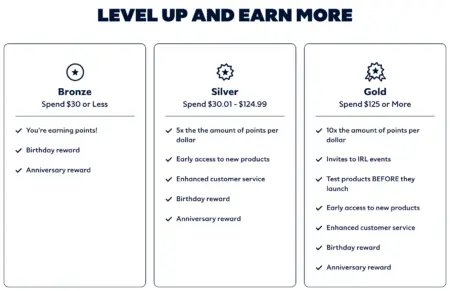
Source: Dollar Shave Club
How to create a brand loyalty program: a step-by-step guide
If you sell monthly subscriptions for makeup products, your program will look very different to a brand that sells high-ticket furniture. But there are some key steps that go into any thoughtful program.
Step 1: Understand your audience and what they care most about from your brand.
74% of consumers expect brands to provide more personalised experiences in 2025. The most successful loyalty programs are customer-driven, and reflect what motivates customers to shop with your brand.
Focus on customers’ average order value (AOV), CLV, and order frequency, then identify trends within these segments. These customers have already demonstrated a higher-than-average commitment to your brand, and will most appreciate tailored messages and rewards.
The average customer of Callie’s Hot Little Biscuit, which sells biscuits, mixes, and spreads, made 2 purchases a year. Using Klaviyo automations, the brand launched progressive flows that incentivise customers to make third and fourth purchases with special offers, which helped power 157.8% YoY growth in revenue from flows.
Step 2: Define your program goals and metrics to track.
Do you want to increase repeat purchases? Encourage referrals? Boost engagement with your brand? Your goal will determine what you offer and how you promote your program. Here’s what to track:
| Loyalty metric | Definition | How to calculate |
| CLV | CLV is the total revenue you can expect from a customer over their entire journey with your brand. | Predicted CLV |
| ROI | Return on investment captures how effective your loyalty program is at driving repeat purchases or larger orders. | ROI = (Net profit of your loyalty program / Total cost) x 100 |
| Net promoter score (NPS) | NPS is based on a single question survey: “On a scale of 0 to 10, how likely are you to recommend [brand] to a friend or colleague?” Scores of 9 or 10 are promoters—customers who are likely to recommend your brand—and scores of 0 through 6 are detractors, who may say negative things about your brand. | NPS score = (percentage of promoters) – (percentage of detractors) |
| Customer loyalty index (CLI) | CLI measures the likelihood that a customer will remain loyal to your brand. You can calculate it using NPS data. CLI is most useful when measured long-term to track trends and the likelihood of customer referrals. | CLI = (number of promoters – number of detractors) / total number of respondents |
| Brand sentiment | Brand sentiment is the overall perception that buyers have of your brand. It’s analyzed via customer feedback on social media, reviews, email replies, and forums. As sentiment is qualitative rather than quantitative, we recommend using an AI-powered review sentiment tool for analysis. | – |
Step 3: Choose a loyalty program structure that aligns with your brand, and decide how your customers can get involved.
The structure you choose should directly connect with your brand and goals. For example, the goal of Popflex’s loyalty program for activewear shoppers is to reward frequent shoppers and encourage customers to share their experiences . Made In’s “Design Trade Program,” meanwhile, is designed to support industry professionals, so it incentivises customers to participate in a community.
Simplicity is key. However you manage your loyalty program, it should be intuitive, quick, and hassle-free for customers to not only join but also track their progress toward a benefit or tier.
“Don’t reinvent the wheel if you don’t need to,” says Tabish Bhimani, principal strategist at Mastrat Digital. “Focus on actions and standards customers are familiar with and build on that.”
Decide on how you’ll manage your program from a technical standpoint, whether members can sign up and manage their rewards in your app, on a website page, or through a dedicated customer loyalty program software.
Loyalty programs are the perfect channel for personalised offers based on customer behaviour and preferences, so you’ll need to know where your data is coming from and how you’re keeping it updated. Our research found that consumers are most likely to share their email, purchase history, phone number, and reviews in exchange for more personalised shopping experiences.
“Use data about the customer’s points, tiers, and VIP status, and echo that back to them in every campaign and abandon cart email—really encourage them to use those points—using universal blocks,” Bhimani continues.
Step 4: Promote your loyalty program with targeted marketing campaigns.
Launch your loyalty program on any platforms where your customers interact with you. Set up automated, segmented, and personalised loyalty marketing flows for both email and SMS.
Post-launch, continue to remind customers about your program—especially new shoppers. Let them know they can redeem rewards in post-purchase emails, order confirmations, product pages, and showcase the benefits of joining.
Step 5: Measure customer loyalty program success on a regular basis and gather feedback from your VIPs
Once your loyalty program is up and running, consider how you’ll track impact. Are customers engaging? Is it helping you meet your goals? Be ready to iterate—a great loyalty program should evolve over time to keep things fresh and exciting.
Track core KPIs, and set up reporting dashboards so it’s easy to keep a pulse on your loyalty program. Measure ROI at regular intervals so you can assess how the program is generating incremental revenue for your brand.
Customer loyalty program platforms and integrations for 2025
To build the loyalty program of your dreams, integrate your customer data platform with your loyalty program for more personalised experiences. Here are some platforms we recommend.
Klaviyo
Klaviyo’s ability to segment customers based on granular data makes it ideal for running loyalty programs. It integrates with loyalty platforms so you can send reminders about rewards, offers for milestones, and tailor product recommendations based on a customer’s loyalty level.
“Your customer data will help you understand what keeps people coming back.”
Here are some ways Klaviyo can elevate your loyalty program:
- Tailored messages
- Automated reward reminders
- Targeted promotions for loyal customers
- Post-purchase follow-ups
Smile.io
Smile.io provides customisable and easy-to-use reward programs that help scaling ecommerce brands transform one-time shoppers into forever customers.
LoyaltyLion
LoyaltyLion was designed to manage reward systems and makes setting up points-based rewards, referral programs, and tiered VIP memberships easy.
Friendbuy
Friendbuy is a SaaS platform powering referral and loyalty programs for the world’s most recognisable ecommerce companies. Create referral program awareness through referral links in emails and texts and reward customers for any actionable data point sent to your CRM.
Klaviyo B2C CRM keeps customer-favorite brand loyalty programs running
A unified customer data platform combined with marketing automation is key to successful loyalty programs that drive engagement and revenue, build brand loyalty, and encourage word of mouth referrals.
That’s why we’ve built the only B2C CRM with a data-first approach, designed to deliver true 1:1 personalisation and create seamless customer experiences without the headaches of complex setups or integrations.
Klaviyo B2C CRM equips brands with the tools to connect, analyze, and engage customers at scale and without complexity—delivering growth without compromise.
Customer loyalty program FAQs
What is customer loyalty?
The standard definition of customer loyalty is consistent brand preference and repeat purchases driven by positive experiences, trust, and customer satisfaction. But the reality is that customer loyalty is a fickle thing that changes with lifestyle, location, and price sensitivity. Life events and income level shift our brand loyalties more than marketing campaigns ever will.
How do brands identify loyal customers?
Look for the outliers. Exact criteria will differ for every brand, but a good place to start is by identifying customers who:
- Consistently spend more than the average shopper per purchase
- Have a lifetime spend with your brand that is above the average CLV
- Return to shop regularly with your brand
What are the 3 Rs of a loyalty program?
The 3 Rs of a loyalty program are reward, recognition, and retention. Reward loyal customers with incentives, recognise them with personalised offers, and retain them by fostering long-term customer relationships.
How can brands reward loyal customers?
Reward loyal customers by offering tailored incentives like discounts, early access to new products, or points they can redeem for future purchases. Customers appreciate personalised rewards based on individual preferences and purchase history, and take note of expressions of appreciation like thank-you messages or birthday offers.
What is the difference between customer loyalty and customer retention?
Customer loyalty is an emotional attachment to a brand or retailer, which leads people to choose that brand consistently over others. Customer retention is the actual business strategy behind keeping existing customers engaged and preventing them from switching to a competitor.


